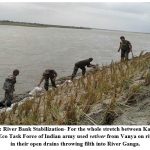Introduction
“The idea of “cultivating like a forest” was adapted to modern times and temperate climates for the first time by Robert Hart in the 1970’s. Four of the documented oldest modern food forests in temperate climates, having reached over 25 years of maturity, are those managed by Martin Crawford in Devon, UK, by Onorio Belussi in Italy, by Panos Manikis in Northern Greece, and by Robert and Robyn Guyton in New Zealand”.1
Food forests address several problems that are due to the industrial food systems. They are multi strata ecosystems and provide healthy food, livelihood opportunities that are very environment friendly. The rate of uptake is low even though the number of food forests is continuously increasing all over the world.2
Creating a Food Forest is a simple method, of mimicking nature as far as possible, and the only human interventions required are to fill the gap of natural resources of that particular area. The introduction of vetiver and nitrogen fixing plants maybe one such intervention in that area’s ecosystem. It is multi-layer (like any dense forest), so trees, shrubs, creepers, tubers grow together. Sow a mix of native plants and a few remunerative ones (if required) with abandon and let nature decide what is best for that area. Food forests are capable of greater density and more biodiversity. This will lead to high productivity which will ensure high yields and continuous food supply throughout the year. Another advantage is that the soil remains healthy as they are self-mulching and cover the soil which improves water conservation by retaining moisture. They have a natural composting process as different insects like earthworms, millipedes etc break down the organic waste and the fallen leaves
Food-Forest is a concept which has evolved from ‘No Till Farming’ and is a multi-layer farming practice which utilises the sunlight optimally and avoids manure, pesticides and other conventional farming practices harmful to the crop, soil and environment. A matured food forest is like a jungle where every layer of vegetation (under the ground, just above the ground, mid-sized plant, tall tree, creeper etc.) produces food and this jungle does not require any inputs in the form of pesticide, fertilizer etc. and does not even require tilling. ‘Food-Forest’ farms enjoy superior yield in terms of vegetables, fruits, herbs and honey while improving the quality of the soil, reducing temperature and increasing water tables. Food forest can be raised on agricultural land, waste land, fallow or degraded forest land and in virtually all agro-climatic zones. They can be raised in all parts of India. They are financially sustainable and more remunerative than traditional agricultural practices being currently followed.
Methodology
The purpose of a case study research is twofold: (1) to provide descriptive information and (2) to suggest theoretical relevance3. Yin3 identified three distinct case study types.: Exploratory, Explanatory, and Descriptive. A case study that is descriptive is one whose goal is to describe a phenomenon. An explanatory case study explains how or why a condition developed. A case study designed to determine the methods or research topics to be applied in another study, is exploratory. Yin4 gave six primary sources of evidence for case study research: documentation, archival records, interviews, direct observation, participant observation, and physical artifacts. The interview can be open-ended, focused, or structured. The researcher may inquire about the informant’s perception of events or facts during an open-ended interview. For this case study, three primary sources – documentation, archival records and open- ended interview, were used.
Vanya Food Forest
Vanya Organic in Khalghat which is situated on the banks of Narmada river in Madhya Pradesh, is trying to restore nature and soil to its original state. They believe that it is a sacred duty to give back to nature what she is giving to you. The dream of Mr. Patanjali Jha was fulfilled by his father Mr. Baldev Jha and his mother Mrs. Parvati Jha who bought 60 acres of land along with five others, including investment banker Sandeep Kothari, in village Akbarpur 17 years ago, by using their retirement funds. They started living on the farm, which was named Vanya Organics. and started planting trees. The vision and commitment of the Jha family has truly made Vanya a labour of love (Picture 1). The inspiration behind Vanya was Masanobu Fukuoka, the Japanese no-till farming visionary and Bhaskar Save, the Gujarati natural farming pioneer.
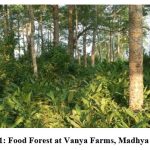 |
Picture 1: Food Forest at Vanya Farms, Madhya Pradesh |
Vanya adopted some very simple practices which restored nature and turned an arid stretch of land into one of the most fertile lands of the country. They follow simple principles of farming i.e.
No tilling or no cultivation – that is no ploughing or turning of the soil.
No fertilizer.
No pesticides.
No weeding by tillage of herbicides: Weeds play a part in building soil fertility and in balancing the biological community.
Mixed cropping
Mulching
Mr. Patanjali Jha is a very vocal and strong advocate of no-till farming. It reduces nitrous oxide (N2O) emissions by 40-70%, depending on rotation. Nitrous oxide is a potent greenhouse gas, 300 times stronger than Carbon Dioxide (CO2), and stays in the atmosphere for 120 years.
Forests are an integral part of nature. Creating food forest is utterly simple. Given in Figure 1 is a diagrammatic representation of the food forest at Vanya.
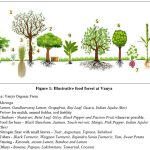 |
Figure 1: Illustrative food forest at Vanya |
Source: Vanya Organic Farm
There is a new definition of the word ‘multi story’- it is tens of thousands of trees with heights varying from 15 feet and less to over 50 feet. It is a huge biodiversity of hundreds of varieties of trees which includes more than 400 mango trees, 5,000 moringa, 5,000 citrus (rangpur lime, mausambi, kaffir line, grapefruit, kagzi lemon), 7,000 papaya, 5,000 Subabool, 500 Neem, and thousands more of perennial Arhar, Amla, Amrood, Kathal, Ber, Pink Pepper, Jamun, Banana, Babool, Glyricidea, Teak, Phalsa, Sharifa, Bel, Wisdom Tree, Swarn Champa, Khajoor and Coconut and the understory consists of thousands of plants of Ginger, Turmeric, Aloe Vera and millions of slips of Khas grass (Vetiver).
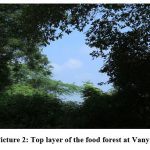 |
Picture 2: Top layer of the food forest at Vanya |
The plants you choose can vary depending upon what is most suited to the region. Moringa and any one or more trees from Citrus family [Lemon, Gandharvraj Lemon, Grapefruit], Bay Leaf, Guava, Indian Jujube (Ber) can be planted at 9 inches distance. They intermingle and support each other. One goes at greater height, and another remains at lower height. The one which goes at greater height has smaller leaves thus allowing sunlight to come through the leaves to nourish lower height trees (Picture 2). The idea is to create biodiversity and let nature decide what is best for that forest (Picture 3). Vetiver, which is one of the best carbon sequesters, must be planted everywhere in the farm forest. Most of the plants discussed have medicinal properties also.
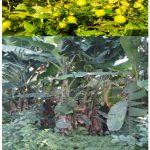 |
Picture 3: Lime, Banana, Turmeric, Pink Pepper, Aloe Vera and Giloy in the intermediate layer of the food forest. |
Bees help in pollinating over 70% of crops all around the world. To save humanity, we need to save bees. Indian Jujube (ber), Black Sheesham, Jaamun, Touch-me-not, Pink Pepper, Mango trees arrange food for bees. Jujube and Pink Pepper bloom at the time of year when honeybees don’t get enough food. For natural fencing, Karonda, Assam Lemon, Bamboo and Lemon can be used.
Microbes found in soil are not supposed to interact with direct sunlight, so every inch of soil should be covered in the first year itself. The sunlight that reaches through the multi storied layer of trees and the mulch on the soil is not harsh and does not destroy the living organisms feeding on the mulch from trees. “Vanya does not use cattle manure and chemicals of any kind as their huge quantities of varied biomass from the trees are sufficient food for the soil. But we do use the Indian cow’s slurry, commonly known as gobar or cowdung” says Mr. Jha. The biomass is also home for thousands of different microorganisms and animal life (different bacteria, fungi, Protozoa, nematodes and larger animals and birds as well) that thrive on decaying plant matter.
According to Mr. Jha, “the guiding principle is to plant with gay abandon. Plants like us enjoy company so go ahead and just plant. Let nature do its own farming and one can watch the magic unfold before one’s own eyes. If the magic happens, the temperature comes down by 2 degrees Celsius in the first year itself, water consumption gets reduced by 60%. This involves low investment and provides high yielding methods of generating healthy food products in a sustainable way”.
Vetiver (Khas)
In his food forest, Mr. Jha is very passionate about growing Vetiver. “The Vetiver Grass Technology (VGT), which is based on the application of vetiver grass (Vetiveria zizanioides), was first developed by the World Bank for soil and water conservation in India in the 1980s. In addition to its very important application in agricultural lands, scientific research conducted in the last 10 years has clearly demonstrated that VGT is also one of the most effective and low-cost natural methods of environmental protection. Hence, VGT is now increasingly being used worldwide for this purpose”5
Vetiver grass can be grown in virtually any agro-climatic zone and it takes root in less than two months and has an exceptional capability to stabilise the soil through its extensive root system. “It has been successful in stabilising the banks of rivers, stopping extension of desertification and recharging groundwater from waste lands. This has helped to use this grass as a soil conservation tool in erosion prone areas. Several soil conservation regions in countries such as Haiti, Philippines and Thailand have done this. Also, the aromatic oil present in the roots of vetiver is used in perfumery and commands a very high commercial value”6. Picture 4 shows river bank stabilization of the Ganges River using vetiver.
According to Mr. Jha, “India, its country of origin is found wanting and is not doing anything serious about vetiver. Four vetiver slips are equivalent to one Poplar tree for carbon sink, lowering temperature and other benefits of the trees. It can be stabilized within two and a half months especially during the monsoons and is a very tough plant withstanding all varieties of temperature and Ph level of soil in our country”. Vetiver helps in increasing ground water level. It has been proved in controlled environments in labs that vetiver helps in the growth of neighboring plants. They have seen the same results at Vanya.
Soil moisture retention
Vetiver strips increased soil moisture storage by a range of 1.9% to 50.1% at various soil depths.
Eroded soils on vetiver plots were consistently richer in nutrient contents than on non-vetiver plots.
Nitrogen use efficiency was enhanced by about 40%.
Water conservation with mulch
The thick cover of Vetiver mulch increases water infiltration and reduces evaporation, particularly important under the hot, dry conditions.
It also protects the soil surface from the impact of raindrops, a major cause of soil erosion.
Mr. Jha firmly believes that we can do Carbon Sequestration with Vetiver. According to him,
One vetiver slip (excluding roots) produces 200 grams of wet biomass in a year.
One square meter can accommodate 40 to 100 vetiver
Vetiver has 42% carbon by mass.
Without considering carbon sequestration by massive roots of vetiver, 3.36 KG to 8.4 KG carbon can be sequestrated per square meter per year.
Indian commitment for carbon sink as per Paris Agreement is 2.5 – 3 Gt CO2e by 2030. This implies that India must create a carbon sink of 3 billion tons of carbon.
With an average of 50 slips in a square meter, in terms of area, it translates to 40 billion square meter which is nearly 1,00,00,000 (1 crore) acres.
In terms of the number of vetiver slips, it translates to 2,000 billion vetiver
Sequestered carbon per year (excluding roots):
Per Square Meter – 3.4 kg to 8.4 kg
Per Square Km – 34,000 Tons to 84,000 Ton
Per 250 Acres – 34,000 Tons to 84,000 Tons
At the same time, it produces a large volume of biomass which has multiple uses ranging from providing feedstock for the cattle to providing feedstock for Compressed Bio Gas (CBG) plants.
Mr. Jha’s success, enthusiasm and support ensured that his brother-in-law, Mr. Himkar Mishra, followed in his footsteps and converted his 40-acre farm in Purnia, Bihar, to a food forest five years back (Picture 5). So, Vanya Organic Farm became a 100-acre food forest spread over two different states. To add to the growing tribe of believers in the sustainability of food forests, Mr. Jha’s son, Shivam Jha, bought a one-acre farm in Purnia and reaped rich benefits of creating a food forest on it within a year (Picture 6). The success of 1- acre farm proved that this model can work for marginal farmers as well, who have small pieces of land.
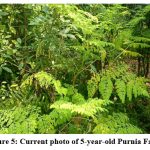 |
Picture 5: Current photo of 5-year-old Purnia Farm |
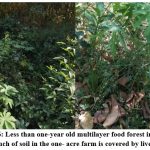 |
Picture 6: Less than one-year old multilayer food forest in Purnia. Every inch of soil in the one- acre farm is covered by live mulch. |
Compressed Bio Gas
Compressed Bio Gas (CBG) or Renewable Natural Gas (RNG) is derived from agriculture waste or other forms of organic waste. It is seen as a very high-tech kind of Gobar gas. A CBG plant produces Sulphur stripped Methane of automotive grade. It also produces a very high quality solid and liquid organic fertilizer as a by-product which has been approved by the Ministry of Agriculture for regular use.7 The CBG can be used to meet energy requirements at all levels, from simple to sophisticated, ranging from running motor pumps in farms to fuel tractors, trucks and automobiles. It is environment friendly as burning of CBG releases lesser greenhouse gases as compared to the traditional fossil fuels. This will help in reducing import of natural gas and crude oil as CBG is a Green fuel. The other advantage is that it can be produced locally and consumed locally. It has the potential to increase farmer incomes and revive the rural sector as the agri-waste and other biomass waste produced in rural areas can be sold to CBG plants at a fair price. It will facilitate employment generation and boost entrepreneurship in rural economy. This will also solve the problem of pollution arising from stubble burning in many parts of our country.
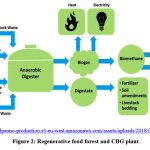 |
Figure 2: Regenerative food forest and CBG plant |
Source: https://alpauno-production.s3-eu-west.amazonaws.com/assets/uploads/2018/09/biogas.jpg
Figure 2 shows that food forests and Vetiver plantations and CBG plants are inextricably linked with each other. Food forests and Vetiver plants are a huge source of Biomass which is the raw material for CBG plants. Therefore, every CBG plant has to be linked with certain sources of Biomass. In the scheme of things where the Government of India wants to set up 5000 CBG Plants by FY 2023-24, the thing which though not spoken of, but is inherent to the scheme, would be linking these CBG Plants with sources of Biomass. Therefore, taking a holistic approach, Mr. Jha suggests that Food Forests and Vetiver Plantations should be looked at together and set up together and called a Regenerative Food Forest. Under SATAT (Sustainable Alternative Towards Affordable Transportation), OMCs (Oil Marketing Companies) will guarantee off-take of CBG at a base price of Rs.46/kg with inflation adjusted increments for a period of 10 years.
Economic Impact and Sustainability of the Solution
The proposed solution creates value for all the stakeholders involved, according to Mr. Jha
Farmers selling their stubble/crop-residue to the CBG Plant at Rs.2/Kg, would see an increase in their income by 25-50% on a sustainable basis. Further savings would be ensured by availability of low-cost organic fertilizers.
Food forests can yield up to 5 lakh rupees per hectare to the agro foresters as net profit through sale of fruits, vegetables, biomass and other agro products obtained from the Food Forest. (Demonstrated in Food Forests located in over 100 acres of land in MP and Bihar
At 20% blending with ethanol and substitution of Compressed Natural Gas (CNG) by CBG, we would save Rs.22,400 crores annually
All the stages of the proposed solution would be eligible to earn Carbon Credits as they substantially reduce emission of CO2 and also sequester Carbon
Large scale migrations from rural to urban parts have been a curse of modern civilization and progress. Since the past 70 odd years, this unidirectional population flow has created catastrophic consequences in cities.
Products like CBG/RNG can revitalize rural economies by creating job opportunities in areas like biomass creation, agroforestry, aggregation, logistics and other support functions.
Participation in the hub and spoke model in CBG offers vast job creation potential. This holds a realistic potential to reduce or even reverse rural migrations. With a huge number of rural and urban youth finding it increasingly difficult to get jobs, this offers a very promising and sustainable option.
A 15 tons per day CBG plant combined with a 750-acre Food Forest can generate sustainable employment/livelihood for around 400 people
Financial Analysis
All the figures of Income and Expense were extrapolated based on actual data as available from the 60 Acres Food Forest of Vanya Farms located in Madhya Pradesh, using the Excel tool. These figures are applicable for current economic conditions of financial year 2022-23 only, as the salaries, capital expenses and values of products are market driven, while the produce output is based on actual data gathered from Vanya Farms. Since Vanya farm has been developed over the course of 20 years, produce projections are based on current enhanced understanding of food forest development.
The projected Expenses, Income and the profit and loss account are shown in Table 1.
Table 1: Projected Expenses, Income and Profit and Loss Account
| Expenses (200 Hectares) * | |||
| Heads Of Expense | First Year | Second Year | Third Year Onwards |
| Salary | 40,00,000 | 44,00,000 | 48,40,000 |
| Capital and Other Expenses | 1,00,00,000 | 40,00,000 | 10,00,000 |
| Total Expenses | 1,40,00,000 | 84,00,000 | 58,40,000 |
| Income (200 Hectares) * | |||
| Heads of Income | First Year | Second Year | Third Year Onwards |
| Fruits/Vegetables/Pulses/Honey | 20,000 | 1,75,000 | 3,50,000 |
| Bio Mass | 20,000 | 75,000 | 1,50,000 |
| Income per Hectare | 40,000 | 2,50,000 | 5,00,000 |
| Income for 200 Hectares | 80,00,000 | 5,00,00,000 | 10,00,00,000 |
| Projected Profit and Loss A/C | |||
| First Year | Second Year | Third Year Onwards | |
| Total Income | 80,00,000 | 5,00,00,000 | 10,00,00,000 |
| Total Expenses | 1,40,00,000 | 84,00,000 | 58,40,000 |
| Profit | -60,00,000 | 4,16,00,000 | 9,41,60,000 |
*All the figures of Income and Expense are based on actual data as available from the 60 Acres Food Forest of Vanya Farms located in Madhya Pradesh.
Conclusion
Mr Patanjali Jha believes that this is a Perfect Circular Economy
Higher farm incomes, self-sufficient and self-sustaining rural economy
No migration to cities, reverse migrations to villages though is a distinct possibility
Huge savings in foreign exchange
Reduced Greenhouse gas emissions, generation of carbon credits to enable India to meet its ‘Green’ commitment as per Paris Climate Accord.
Healthier villages and livestock, reduced healthcare bills
Restoration of soil fertility, savings on imported fertilizers.
Higher water tables and cleaner water bodies, a job pending for decades.
Acknowledgement
There has been no financial support from any individual or organisation for this case study.
Conflict of Interest
There is no conflict of interest
References
- Riolo F. The social and environmental value of public urban food forests: The case study of the Picasso Food Forest in Parma, Italy. Urban Forestry and Urban Greening, 2019, 45, 126225
CrossRef - Albrecht S., Wiek A. Implementing sustainable food forests: Extracting success factors through a cross-case comparison. Journal of Agriculture, Food Systems, and Community Development, 2021, 11(1), 183–200. https://doi.org/10.5304/jafscd.2021.111.019
CrossRef - Winston M, Tellis. Application of a Case Study Methodology. Semantic Scholar. https://pdfs.semanticscholar.org/65da/2ceb14484c1480d5a3c6 645cb48fa2be31ae.pdf?_ga= 2.169677793.197089264.1668259598-1636742651.1668259598. 1997
- Case Study Methodology. Methodspace. https://www.methodspace .com/blog/case-study-methodology#:~:text=Case% 20study%20 methodology %20can% 20entail, what%20is%20included%20and%2
- Truong P. The Global Impact of Vetiver Grass Technology on the Environment, Plenary Paper for the International Vetiver Conference, January 2000, Thailand.
- Gnansounou E., Catarina M. Alves, Raman J.K. Multiple applications of vetiver grass – a review. International Journal of Environmental Science, 2017,2, 125-141
- SATAT Initiative To Promote Compressed Bio-Gas As Green Transport Fuel In Vehicles https://imp.center/gov/satat-initiative-compressed-bio-gas-cbg-green-transport-fuel-vehicles/


